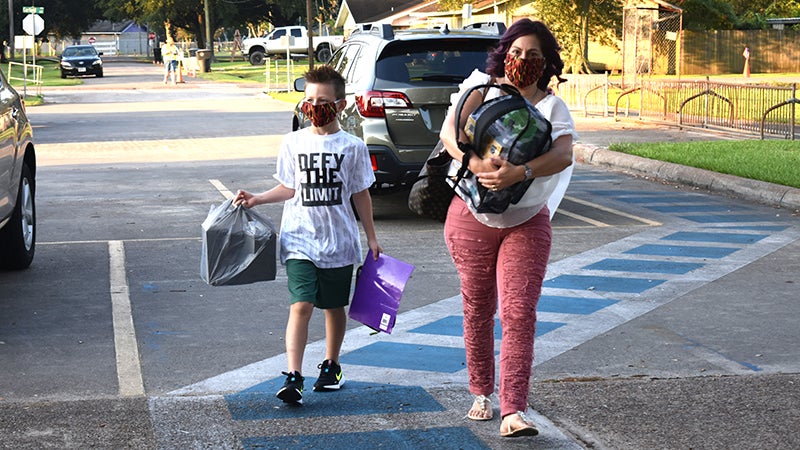School board members hear about importance of reading on level by 3rd grade
Published 12:29 am Thursday, March 25, 2021

- Giovanni Alfero, left, is walked to the front of Van Buren Elementary school by his mom, Winde Alfero, in August 2020. Students in Port Neches-Groves Independent School District returned to classes for the start of the 2020-21 school year for in-person instruction.
|
Getting your Trinity Audio player ready...
|
PORT NECHES — Trustees with the Port Neches-Groves Independent School district met this week with a representative of Region V to discuss meeting pre-pandemic state-mandated goals in a pandemic era.
Among several changes to public education in Texas, House Bill 3, passed in 2019, implements new testing goals for students in 3rd grade and those graduating from high school.
“The major focus here is on 3rd grade reading,” Region V Deputy Executive Director Byron Terrier told the board. “If a student is not reading on grade level by 3rd grade, the likelihood that they will ever read on grade level is almost non-existent. And each year after that they’re not on grade level – again – it is exponentially less likely that they’ll ever catch up.”
Texas students who take the STAAR test are scored in one of four categories: did not meet grade level, approaches grade level, meets grade level, and masters grade level.
In 2018, 23 percent of 3rd grade students state-wide did not meet grade level in reading.
As part of HB3, 60 percent of 3rd grade students should meet grade level on standardized tests by the year 2030. The legislation asks districts to create annual plans in order to obtain the objective.
“The meet standards – 60 percent – that’s a pretty lofty goal,” Terrier said. “It really is. But that’s what we want: to set lofty goals. We have 10 years to do it.”
Superintendent Mike Gonzales agreed, but had faith in the district’s ability.
“We’ve always been above the state standard, so I wouldn’t doubt that we’re at 60 percent or above,” he said during the training session.
The challenge, he said, is coming back from lost time due to COVID-19.
“This year is going to create a lot of problems for a lot of school districts because, we already know – I’ve shared studies with you – that every time a school year is disrupted like it was last year at this time, it really hurts kids. And it’s going to take them at least two years to catch up.”
That, the superintendent said, was a driving force behind the district’s decision to start the current school year in-person without the option for virtual learning.
“Research shows that the most influential factor in student learning is the person standing in front of the classroom. It’s the teacher,” Terrier said.
Texas students did not take the STAAR test in the 2019-2020 school year, as the spring test would have been administered around the time schools closed due to COVID. This year most students will be required to take the test, but districts will not be graded on the results.
“These things are not going to go away,” Gonzales said. “The state’s not going to say, ‘Hey, don’t worry about it. You don’t have to do this.’ They’re still saying we have to meet these goals even though last year we didn’t take the STAAR test. This year, we’re going to take the STAAR test and we can use it as a measuring tool, and that’s really all we can do with it because they’re not going to grade us on how well we do or how poorly we do. But they’re not going to change their stance on this even though many of our kids have not been in school.”
District policy requires any student that’s come in contact with a COVID-positive person to quarantine for 10 days.





